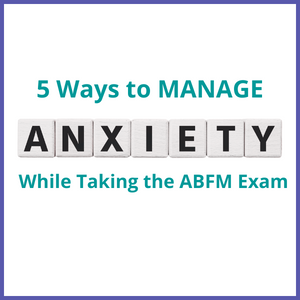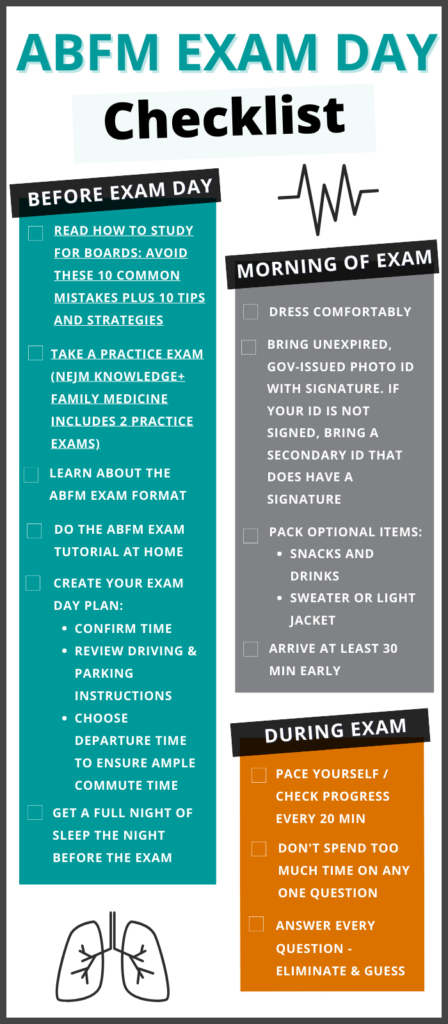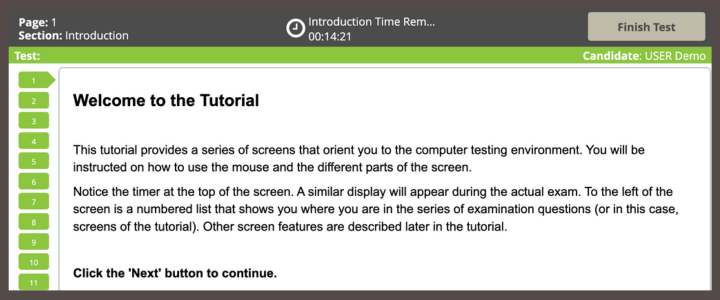If you have an ABFM exam approaching, you may have questions and some anxiety about what lies ahead. Whether you’re a first-timer or it’s been a while since your last exam, this guide is designed to ease your worries and equip you with the essential information you need for a smooth test-day experience. Read through the guide and download our ABFM Exam Day checklist to ensure you are prepared for success!
| Schedule | Time |
| Registration | Varies |
| Identity verification, review exam rules, exam tutorial, section 1 instructions | ~15 min. |
| Exam Section 1 | Up to 95 min. for 75 MCQs |
| Optional Break 1 | ≤100 min. total for 3 breaks |
| Identity verification, section 2 instructions | ~5 min. |
| Exam Section 2 | Up to 95 min. for 75 MCQs |
| Optional Break 2 | ≤100 min. total for 3 breaks |
| Identity verification, section 3 instructions | ~5 min. |
| Exam Section 3 | Up to 95 min. for 75 MCQs |
| Optional Break 3 | ≤100 min. total for 3 breaks |
| Identity verification, section 4 instructions | ~5 min. |
| Exam Section 4 | Up to 95 min. for 75 MCQs |
| Optional Survey | ~15 min. |
| Updated November 2023 | |
How long is the ABFM Exam?
The ABFM exam will last a maximum of nine (9) hours, depending on the time you spend answering questions and taking breaks. The nine hours includes time for onboarding activities and procedures, plus exam time and break time. Take a look at the table for a breakdown of your allotted time.
ABFM Board Exam Structure
The structure of the ABFM exam features 300 multiple-choice questions (MCQs), each requiring a single best answer. The test stretches over four 95-minute sessions, in which you’ll tackle 75 questions each. There’s an allowance of 100 minutes for optional breaks, so you’ll have opportunities to recharge and refocus.
Family Medicine Exam — What to Expect at the Testing Center
The Family Medicine Exam is conducted at Prometric testing centers. ABFM recommends arriving at least 30 minutes before your appointment to ensure you have adequate time for check-in and security measures. Make sure to verify your appointment details on your E-ticket to ensure you have the correct address for the testing center (noting that some cities have more than one location), and allocate sufficient time for travel and parking.
Upon arrival, a Prometric employee will verify your identity and assign you a locker. Be sure to leave personal items such as purses, backpacks, watches, hats, cellphones, or other electronic devices in your locker (or at home) and avoid accidentally bringing them into the exam room. Doing so may result in the invalidation of your entire exam.
Expect to go through a security check (see “Security in the Test Center” below) before being seated at your examination station. As you enter the testing room, you’ll receive an erasable board for notes and an administrator will escort you to your workstation and launch your exam. You’ll review the ABFM rules, exam tutorial (more below), and section 1 instructions, before beginning the exam.
ABFM Exam Test Center Security
Security measures at the test center are comprehensive. Prepare to be scanned with a metal detector wand each time you enter the exam room. You’ll undergo a physical inspection: you’ll need to raise your pants legs above your ankles and pull up your shirt sleeves, if you’re wearing them. You’ll also need to turn out and empty your pockets to confirm there are no prohibited items. The entire exam center is continuously monitored by recorded video, and test administrators perform ongoing walk-throughs and also keep an eye on test stations through an observation window.
What to Bring to the ABFM Exam
- A valid, unexpired government-issued photo ID with a signature, such as a driver’s license, passport, or state/county identification card. If your ID does not contain your signature, such as a military ID, a secondary ID with a signature will also be required.
- Your E-Ticket as proof of your appointment. The name on your E-Ticket needs to match your ID.
- Nutritious lunch, snacks, and drinks for breaks between sessions. Water in a covered, transparent, label-free container will be allowed in the examination room.
- A light sweater or jacket, in case you need an extra layer while taking the test (outerwear is not permitted in the exam room).
Save Time and Mental Energy: Do the ABFM Exam Tutorial at Home
We recommend viewing ABFM’s optional online tutorial before your test day to familiarize yourself with features of the exam. Watching this in advance is a valuable 30 minutes of your preparation time. It’s ideal to watch the tutorial early in your board preparation so that you have it top of mind as you study. Even if you have experience with computer-based testing, familiarizing yourself with the electronic features beforehand can enhance your efficiency during the exam and alleviate potential anxiety. Then review it again shortly before exam day to remind yourself of simple essentials, such as:
- Basic navigation in the app
- How to highlight key information
- Using the strike-out feature to eliminate wrong answers
- How to flag questions you would like to revisit if you have time
- How to access the calculator and the table of normal laboratory values
Tips for Answering Family Medicine Exam Questions
All ABFM questions are multiple-choice, featuring one correct answer and four distractors. Each section predominantly consists of case-based questions, complemented by questions that target specific knowledge points. Some questions incorporate figures, videos, or audio (headphones are provided). As you go through the exam, keep in mind these basic test-taking tips:
- Answer every question, even if you must guess. The exam is pass-fail with a set minimum passing standard. Your overall performance on the entire test is evaluated and unanswered questions are scored as incorrect.
- Don’t dwell on a single question. If one is taking too much time, make an educated guess, flag it for review, and proceed to the next question.
- Avoid flagging too many questions in a session; it can make it challenging to prioritize if you have extra time at the end.
- For non-case-based questions, you’ll likely either know the answer or not. If unsure, use the strategy of eliminating incorrect options and choose the best from the remaining answers.
For additional strategies, check out our blog post, Strategies for Working through ABIM Board Questions. Even though it was written for your Internal Medicine colleagues, you’ll find invaluable information to hone your skills for tackling the complex case-based questions that make up medical specialty exams.
Overcoming Test-Day Anxiety: 5 Ways to Stay Centered While Taking the ABFM Exam
- Rely on Proven Strategies. Even seasoned physicians can experience anxiety when taking high-stakes exams. To minimize stress, adopt these effective tactics: 1) Ensure ample rest in the nights leading up to the exam, 2) Wear comfortable clothing, 3) Pre-plan your route to the exam center as well as where you’ll park, 4) Arrive ahead of schedule, 5) Familiarize yourself with available tools and resources, and 6) Envision yourself calm and confident on exam day.
- Equip yourself with a pacing strategy. Every testing room features a wall clock, and your computer screen displays a timer showing the remaining session time. An alert box will display beneath the exam clock indicating when there are 30, 15, and 5 minutes left in the current section. The navigation feature will show your progress and the numbered buttons change appearance to indicate different question states: Current, Attempted, Unattempted, and Flagged. Use both the timer and the navigation feature to maintain pace.
- Every 20 minutes, assess your progress to ensure you’re on pace. If you’re progressing faster than anticipated, you may want to slow down. While you might be adept at exams, it’s crucial to ensure you’re thoroughly reading each question.
- Remember that it’s okay not to know everything. Exams are designed with a combination of challenging and easy questions, adhering to the principles of exam creation and assessment best practices. Note that your exam may contain questions that are being evaluated for inclusion in future exams that will not be scored. You will not know which questions fit into this bucket.
- Take advantage of scheduled breaks. You’ll get 100 minutes of total break time, structured to accommodate two 15-minute breaks and one 70-minute meal break between exam content sections. However, you’ll have the flexibility to use the break time as you see fit in between exam sessions. Use your breaks to take a brisk walk to alleviate test day stress, eat a healthy lunch or snack, and stay adequately hydrated. If you need an unscheduled break, raise your hand so the proctor can pause the test. But remember: The 95-minute clock for the session will continue.
ABFM Exam Test Results
Before processing ABFM test results, a psychometric analysis is conducted on the exam data to eliminate underperforming questions and determine a minimum passing score (MPS). Candidates usually receive preliminary results 3-7 business days after completing the examination. A preliminary pass (or fail) is provided when performance is decisively above (or below) the MPS. If scores are near the MPS, a pending result is issued. Official examination results are typically available 6-8 weeks from the examination window’s closing date.
Best of luck to everyone taking the ABFM exam. If you have any preparation or exam-taking tips, please share them below. We’d love to hear from you!
How NEJM Knowledge+ Family Medicine Board Review Helps
The Adaptive Learning algorithm in NEJM Knowledge+ Family Medicine Board Review harnesses the power of spaced repetition to ensure you retain new information for the long term. The program tests your knowledge in different contexts and question formats so you’ll develop the comprehensive understanding you’ll need when answering the case-based questions on the ABFM exam. The system is designed to respect your time by avoiding redundant questions on topics you’ve already mastered. It continually adapts to your needs, crafting a learning path that is perfectly attuned to your progress, ultimately maximizing your efficiency and saving you valuable study hours.
The program also strengthens metacognitive skills by encouraging you to evaluate your confidence level while answering questions. This self-reflective process encourages you to “think about your thinking,” which empowers you to approach exam questions with confidence and agility on the big day.
Within NEJM Knowledge+ Family Medicine Board Review you’ll find two timed practice exams that simulate the real exam environment, allowing you to fine-tune your pacing while responding to questions. After each practice exam, you can analyze your results, compare your performance to that of your peers, and access comprehensive feedback, key learning points, and references for every question. You can also earn AMA PRA Category 1 Credits™ and AAFP Prescribed Credits as you learn and prepare for your exam.
Discover how NEJM Knowledge+ Family Medicine Board Review can help you prepare for and pass your exam, earn CME credits, and improve your family medicine practice.





